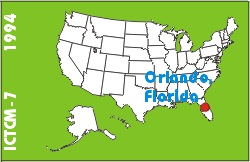
Electronic Proceedings of the Seventh Annual International Conference on Technology in Collegiate MathematicsOrlando, Florida, November 17-20, 1994Paper C020Twelve Practical Ideas for the Use of the TI-82 in the Second-Term Calculus Course |
Carl R. SpitznagelDepartment of Mathematics and Computer Science John Carroll University Cleveland, OH 44118 USA Phone: (216) 397-4351 spitz@jcvaxa.jcu.edu list of all papers by this author |
| Click to access this paper: |
ABSTRACT
The TI-82 calculator can be used to help motivate and enliven many of the fundamental ideas in the second-term calculus course. This can be done easily and naturally, without having to abandon your present calculus text or adopt a radically different teaching style.Intended for faculty members contemplating the use of the TI-82 in teaching calculus, this companion paper to the author's 'Twelve Practical Ideas for the Use of the TI-82 in the First-Term Calculus Course,' presented at the Sixth Annual ICTCM, describes, in practical terms, twelve natural ways in which the calculator can be integrated into your present course, to enhance students' understanding and appreciation of various concepts.
As an example, the natural log function can be introduced via the TI-82's fnInt function. Begin by giving each student one of the numbers .2, .4, .6, ... 3.8, 4. Then have them compute, on their TI-82's, the value of fnInt(1/X,X,1,A), where A represents their personal number. Record these values in a table on the board. Have the students plot these points by hand, and attempt to draw the graph.
Next, have them enter the formula Y1 = 1/X, and deactivate it. Then enter Y2 = fnInt(1/X,X,1,X,2), and graph in the window [0,9.4] X [-3.1,3.1], which has the correct aspect ratio and will show the essential features of the graph. Why does the graph take so long (about 40 seconds)? Use TRACE to verify that the y-coordinates are the same as those previously calculated.
Next introduce the LN key on the calculator, and have the students graph Y3 = ln X along with the graph of Y2. Is there any difference? Having established graphically that the integral from 1 to x of 1/t is the same as the calculator's LN function, have the students use LN instead of the numerical integration, in order to save time. Enter Y1 = ln X and Y2 = nDeriv(Y1,X,X). Deactivate Y1 and graph Y2, using ZOOM ZDecimal. Do you recognize the graph of the resulting function, the derivative of the integral from 1 to x of 1/t ? For students with good memories, this will not be a surprise.
This and eleven other practical ideas are discussed in this paper.
Keyword(s): calculus, graphing calculators, TI-82
